List of European dinosaurs facts for kids
Dinosaurs first appeared during the Triassic period, about 230 million years ago. Back then, all the Earth's land was joined together in one huge continent called Pangaea. Europe was part of this supercontinent.
Later, around the start of the Jurassic period (about 30 million years after dinosaurs first appeared), Pangaea began to break apart. It split into two main landmasses: Laurasia and Gondwana. A large ocean called the Tethys Ocean started to cut deep into Pangaea, causing much of Europe to be covered by water.
By the Cretaceous period, from 145 to 66 million years ago, the continents were starting to look more like they do today. However, they weren't in their current positions. Europe was still a tropical place, often a chain of small islands and mini-continents like Baltica and Iberia.
Many dinosaur fossils from Europe come from the time when the Jurassic and Cretaceous periods met. This helps us learn a lot about European dinosaurs from that era. Towards the very end of the Cretaceous period, about 66 million years ago, dinosaurs were common in western and central Europe. For example, Struthiosaurus and Canardia lived in Europe during this time.
Contents
List of European Dinosaurs
Valid Genera
| Name | Year | Formation | Location | Notes | Images |
|---|---|---|---|---|---|
| Abditosaurus | 2022 | Tremp Group (Late Cretaceous, Maastrichtian) | This large sauropod was related to others but seems to have moved to Europe from another continent. | 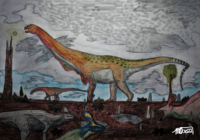 |
|
| Acanthopholis | 1867 | Chalk Group (Early Cretaceous to Late Cretaceous, Albian to Cenomanian) | It had oval-shaped armor plates and long spikes on its body. |  |
|
| Adynomosaurus | 2019 | Tremp Group (Late Cretaceous, Maastrichtian) | This dinosaur was quite basic in its features, even though it lived later in the Cretaceous period. |  |
|
| Aepisaurus | 1852 | Grès vert (Early Cretaceous, Albian) | We only know this dinosaur from one arm bone, which looks a bit like bones from other sauropods. | 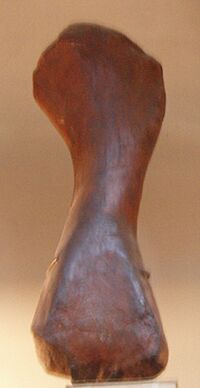 |
|
| Ajkaceratops | 2010 | Csehbánya Formation (Late Cretaceous, Santonian) | Its ancestors might have traveled from Asia by hopping between islands. | 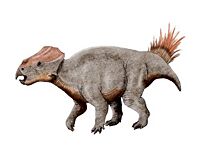 |
|
| Allosaurus | 1877 | Lourinhã Formation (Late Jurassic, Kimmeridgian to Tithonian) | Two types of Allosaurus are known from the United States. The European one might be the same as A. fragilis. | ||
| Alocodon | 1973 | Cabaços Formation (Late Jurassic, Oxfordian) | This dinosaur had teeth with vertical grooves. | 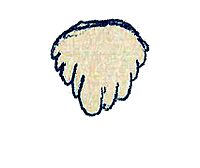 |
|
| Altispinax | 1923 | Wadhurst Clay Formation (Early Cretaceous, Valanginian) | It had long spines on its back, possibly supporting a hump, like Concavenator. |  |
|
| Amanzia | 2020 | Reuchenette Formation (Late Jurassic, Kimmeridgian) | One bone has preserved cartilage. It was first thought to be a different dinosaur. |  |
|
| Ampelosaurus | 1995 | Argiles et Grès à Reptiles Formation, Grès de Labarre, Gres de Saint-Chinian, Marnes Rouges Inférieures Formation (Late Cretaceous, Maastrichtian) | It had three kinds of bony armor plates: spines, flat plates, and round bumps. |  |
|
| Anoplosaurus | 1879 | Cambridge Greensand (Early Cretaceous, Albian) | It's thought to be an ankylosaur, even though no armor plates have been found. | 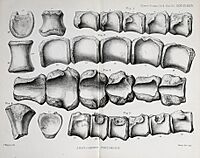 |
|
| Aragosaurus | 1987 | Villar del Arzobispo Formation (Early Cretaceous, Berriasian) | This dinosaur reportedly had a unique hip bone. |  |
|
| Arcovenator | 2014 | Argiles et Grès à Reptiles Formation (Late Cretaceous, Campanian) | It was most closely related to meat-eating dinosaurs from India and Madagascar. |  |
|
| Arenysaurus | 2009 | Tremp Group (Late Cretaceous, Maastrichtian) | This was one of the last lambeosaurines (a type of duck-billed dinosaur) before they died out. |  |
|
| Aristosuchus | 1887 | Wealden Group (Early Cretaceous, Barremian) | It might have had long claws, based on some toe bones found. |  |
|
| Asylosaurus | 2007 | Unnamed fissure fill (Late Triassic, Rhaetian) | Its bones were first thought to belong to Thecodontosaurus. | 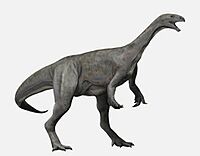 |
|
| Atsinganosaurus | 2010 | Argiles et Grès à Reptiles Formation (Late Cretaceous, Maastrichtian) | It belongs to a special group of titanosaurs found in southwestern Europe. |  |
|
| Aviatyrannis | 2003 | Alcobaça Formation (Late Jurassic, Oxfordian to Tithonian) | Though first called a tyrannosauroid, it might be the oldest known ornithomimosaur (an ostrich-like dinosaur). | 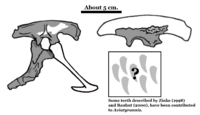 |
|
| Barilium | 2010 | Wadhurst Clay (Early Cretaceous, Valanginian) | This dinosaur was strongly built with powerful backbones and short spines. |  |
|
| Baryonyx | 1986 | Weald Clay Formation (Early Cretaceous, Barremian) | One Baryonyx fossil had fish and a young iguanodont in its stomach, meaning it ate many different things. |  |
|
| Betasuchus | 1932 | Maastricht Formation (Late Cretaceous, Maastrichtian) | This was the first land animal named from the Maastrichtian age. | 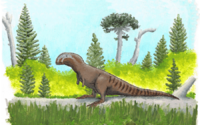 |
|
| Blasisaurus | 2010 | Arén Formation (Late Cretaceous, Maastrichtian) | We only know it from part of a skull, but it's different from other duck-billed dinosaurs of its time. |  |
|
| Bothriospondylus | 1875 | Kimmeridge Clay (Late Jurassic, Kimmeridgian) | Many bones were once thought to belong to this dinosaur, but most have been moved to other groups. | 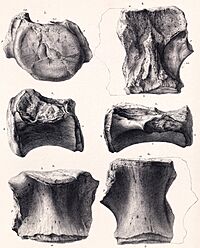 |
|
| Bradycneme | 1975 | Sânpetru Formation (Late Cretaceous, Maastrichtian) | It might have been a type of alvarezsaurid, a group of small, bird-like dinosaurs. | ||
| Brighstoneus | 2021 | Wessex Formation (Early Cretaceous, Barremian) | It had a long snout with a small bump at the end. |  |
|
| Burianosaurus | 2017 | Peruc-Korycany Formation (Late Cretaceous, Cenomanian) | It may be closely related to the rhabdodontids, a group of small, plant-eating dinosaurs. | 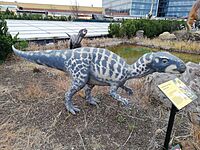 |
|
| Calamosaurus | 1891 | Wessex Formation (Early Cretaceous, Barremian) | We only know it from two neck bones. Many other bones were linked to it, but it's hard to be sure. |  |
|
| Calamospondylus | 1866 | Wessex Formation (Early Cretaceous, Hauterivian) | We only know it for sure from a hip bone and other related parts. | ||
| Callovosaurus | 1980 | Oxford Clay (Middle Jurassic, Callovian) | This is the oldest known dryosaurid, a type of plant-eating dinosaur. |  |
|
| Calvarius | 2023 | Tremp Group (Late Cretaceous, Maastrichtian) | It might have walked on two legs and run fast, like earlier ornithopods. |  |
|
| Camarillasaurus | 2014 | Camarillas Formation (Early Cretaceous, Barremian) | It was first called a ceratosaur, but now it's thought to be a spinosaurid (a type of fish-eating dinosaur). |  |
|
| Camelotia | 1985 | Westbury Formation (Late Triassic to Early Jurassic, Rhaetian to Hettangian) | This was one of the largest sauropod-like dinosaurs that wasn't a true sauropod. |  |
|
| Canardia | 2013 | Marnes d'Auzas Formation (Late Cretaceous, Maastrichtian) | It might have been a close relative of Aralosaurus, another duck-billed dinosaur. | 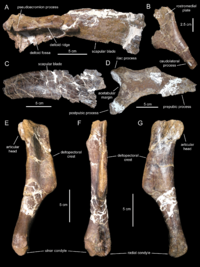 |
|
| Cardiodon | 1841 | Forest Marble Formation (Middle Jurassic, Bathonian) | This was the first sauropod ever named, but we only know it from a tooth. | 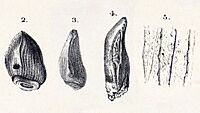 |
|
| Ceratosuchops | 2021 | Wessex Formation (Early Cretaceous, Barremian) | It's different from Baryonyx in small details of its skull. |  |
|
| Cetiosauriscus | 1927 | Oxford Clay (Middle Jurassic, Callovian) | Its place in the sauropod family tree has been debated a lot. | 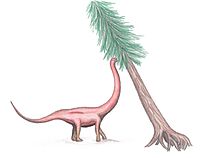 |
|
| Cetiosaurus | 1841 | Rutland Formation (Middle Jurassic, Bajocian to Bathonian) | This was the first sauropod known from good fossils. People once thought it was a large sea animal. | 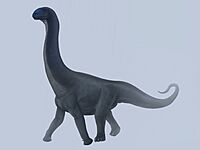 |
|
| Chondrosteosaurus | 1876 | Wessex Formation (Early Cretaceous, Barremian) | The air sacs in its backbones were first thought to be filled with cartilage. | 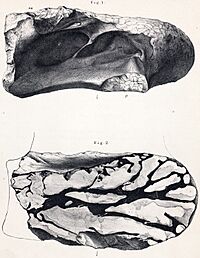 |
|
| Compsognathus | 1859 | Alcobaça Formation?, Portland Stone, Solnhofen Limestone (Late Jurassic, Kimmeridgian to Tithonian) | This was one of the smallest non-bird dinosaurs known. |  |
|
| Concavenator | 2010 | La Huérguina Formation (Early Cretaceous, Barremian) | It had bumps on its arm bone, which might have held feathers or been for muscle attachments. |  |
|
| Craspedodon | 1883 | Unnamed formation (Late Cretaceous, Santonian) | It might be the first neoceratopsian (a type of horned dinosaur) found in Europe. | 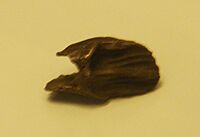 |
|
| Craterosaurus | 1874 | Woburn Sands Formation (Early Cretaceous, Aptian to Albian) | It might be the same dinosaur as Regnosaurus. | 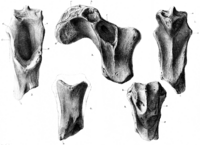 |
|
| Cruxicheiros | 2010 | Chipping Norton Limestone (Middle Jurassic, Bathonian) | Its exact place in the dinosaur family tree is not clear. | 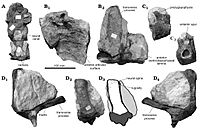 |
|
| Cryptosaurus | 1869 | Ampthill Clay (Late Jurassic, Oxfordian) | We only know this dinosaur from a single thigh bone. | 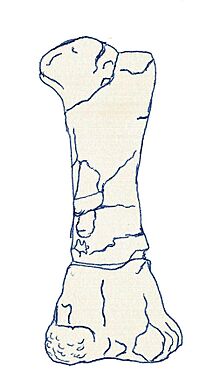 |
|
| Cumnoria | 1888 | Kimmeridge Clay (Late Jurassic, Kimmeridgian) | It might be a type of Camptosaurus or something more basic. | 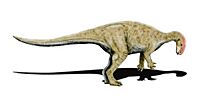 |
|
| Dacentrurus | 1902 | Alcobaça Formation, Argiles d'Octeville, Kimmeridge Clay, Lourinhã Formation, Villar del Arzobispo Formation (Late Jurassic to Early Cretaceous, Kimmeridgian to Berriasian) | Many fossils of this dinosaur have been found, showing it lived in a wide area. |  |
|
| Demandasaurus | 2011 | Castrillo de la Reina Formation (Early Cretaceous, Barremian to Aptian) | It was most closely related to African rebbachisaurids, suggesting dinosaurs moved between these continents. | 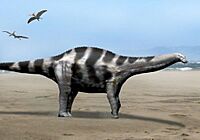 |
|
| Dinodocus | 1884 | Lower Greensand Group (Early Cretaceous, Barremian) | The only known arm bone is almost complete. | 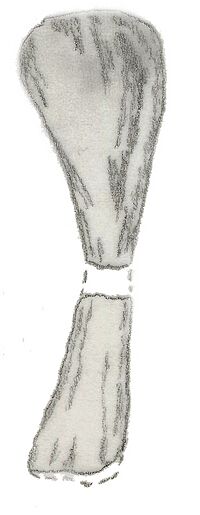 |
|
| Dolichosuchus | 1932 | Löwenstein Formation (Late Triassic, Norian) | It was first thought to be an early crocodile. |  |
|
| Draconyx | 2001 | Lourinhã Formation (Late Jurassic, Tithonian) | It might have been part of an ornithopod group not found in North America. |  |
|
| Dracopelta | 1980 | Lourinhã Formation (Late Jurassic, Tithonian) | Its leg structure suggests it might have been a fast runner. | ||
| Dracoraptor | 2016 | Lias Group (Early Jurassic, Hettangian) | It might have lived near the shore because of its island home. |  |
|
| Dromaeosauroides | 2003 | Jydegaard Formation (Early Cretaceous, Berriasian) | A fossilized poop (coprolite) with fish remains was found, but it could belong to a turtle. | 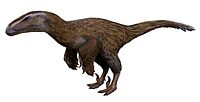 |
|
| Dubreuillosaurus | 2005 | Calcaire de Caen (Middle Jurassic, Bathonian) | It would have lived in a coastal swamp with mangrove trees. |  |
|
| Duriatitan | 2010 | Kimmeridge Clay (Late Jurassic, Kimmeridgian) | It was first named as a type of Cetiosaurus. | 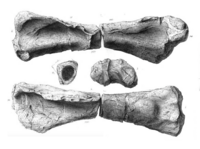 |
|
| Duriavenator | 2008 | Inferior Oolite (Middle Jurassic, Bajocian) | This is the most basic megalosaurine known, which fits with its early time period. |  |
|
| Echinodon | 1861 | Purbeck Group (Early Cretaceous, Berriasian) | It was first wrongly identified as a plant-eating lizard. |  |
|
| Efraasia | 1973 | Löwenstein Formation (Late Triassic, Norian) | Some bones now linked to this dinosaur were first put into different groups. |  |
|
| Elopteryx | 1913 | Sânpetru Formation (Late Cretaceous, Maastrichtian) | It might be closely related to Balaur and Gargantuavis. |  |
|
| Emausaurus | 1990 | Ciechocinek Formation (Early Jurassic, Toarcian) | This is one of the oldest and most basic thyreophorans (armored dinosaurs). | 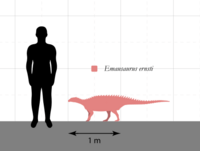 |
|
| Eotyrannus | 2001 | Wessex Formation (Early Cretaceous, Barremian) | It had grasping hands with three long fingers. |  |
|
| Eousdryosaurus | 2014 | Lourinhã Formation (Late Jurassic, Kimmeridgian) | It was called a dryosaurid, but one study suggests it's close to elasmarians. | ||
| Erectopus | 1923 | La Penthiève Beds (Early Cretaceous, Albian) | This is one of the youngest known European carnosaurs (large meat-eating dinosaurs). |  |
|
| Eucamerotus | 1872 | Wessex Formation (Early Cretaceous, Barremian) | It shows a lot of evidence of air sacs in its bones. | ||
| Eucercosaurus | 1879 | Cambridge Greensand (Early Cretaceous, Albian) | Sometimes it's seen as an ankylosaur, but one study puts it with iguanodonts. | ||
| Euronychodon | 1991 | Argiles et sables de Taveiro (Late Cretaceous, Campanian to Maastrichtian) | We only know it from teeth. Another type has been found in Uzbekistan. | ||
| Europasaurus | 2006 | Süntel Formation (Late Jurassic, Oxfordian to Kimmeridgian) | It was much smaller than other sauropods because it lived on an isolated island. | 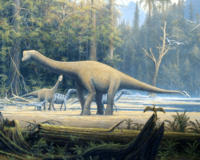 |
|
| Europatitan | 2017 | Castrillo de la Reina Formation (Early Cretaceous, Barremian to Aptian) | Some of its fossils include several backbones. Its name honors director Clint Eastwood. | 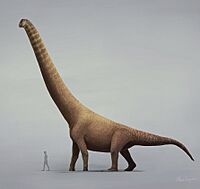 |
|
| Europelta | 2013 | Escucha Formation (Early Cretaceous, Albian) | Almost its entire skeleton has been found. |  |
|
| Eustreptospondylus | 1964 | Oxford Clay (Late Jurassic, Oxfordian) | It might have swum between islands, like a Komodo dragon. |  |
|
| Fylax | 2021 | Figuerola Formation (Late Cretaceous, Maastrichtian) | It lived very late in the Cretaceous, even though it was a more basic type of dinosaur. | 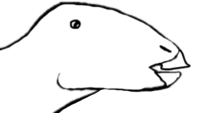 |
|
| Galvesaurus | 2005 | Villar del Arzobispo Formation (Late Jurassic, Kimmeridgian to Tithonian) | It's also spelled Galveosaurus. Two groups of scientists named the same fossil without knowing about each other. | ||
| Garrigatitan | 2021 | Argiles et Grès à Reptiles Formation (Late Cretaceous, Campanian) | Fossils of both adult and young dinosaurs have been found. | ||
| Garumbatitan | 2023 | Arcillas de Morella Formation (Early Cretaceous, Barremian) | It had a smaller claw on its third toe. | 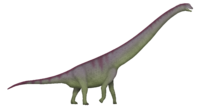 |
|
| Genusaurus | 1995 | Bevons Beds (Early Cretaceous, Albian) | It has been suggested to be either a noasaurid or an abelisaurid. | ||
| Gideonmantellia | 2012 | Camarillas Formation (Early Cretaceous, Barremian) | It was first wrongly identified as a Hypsilophodon fossil. |  |
|
| Gigantosaurus | 1869 | Kimmeridge Clay (Late Jurassic, Kimmeridgian) | It might have had armor plates. |  |
|
| Haestasaurus | 2015 | Hastings Beds (Early Cretaceous, Berriasian to Valanginian) | It has impressions of different-sized hexagonal scales on its skin. |  |
|
| Halticosaurus | 1908 | Löwenstein Formation (Late Triassic, Norian) | Its bones were historically mixed up with those of unrelated animals. | ||
| Heptasteornis | 1975 | Sânpetru Formation (Late Cretaceous, Maastrichtian) | It was once thought to be a giant prehistoric owl. |  |
|
| Histriasaurus | 1998 | Unnamed formation (Early Cretaceous, Hauterivian to Barremian) | Even though it was found in Europe, it might have lived between southern Europe and Africa. | 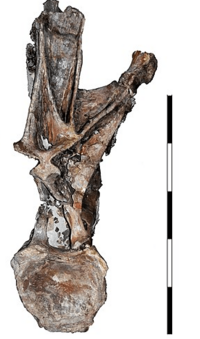 |
|
| Horshamosaurus | 2015 | Weald Clay (Early Cretaceous, Barremian) | A bone thought to be a shin bone was later identified as a hip bone. |  |
|
| Hungarosaurus | 2005 | Csehbánya Formation (Late Cretaceous, Santonian) | It had a raised shoulder, which might have helped it eat leaves from tall plants. | 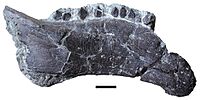 |
|
| Hylaeosaurus | 1833 | Grinstead Clay Formation?, Tunbridge Wells Sand Formation (Early Cretaceous, Valanginian) | This was one of the three animals first used to define dinosaurs, along with Iguanodon and Megalosaurus. |  |
|
| Hypselosaurus | 1869 | Argiles et Grès à Reptiles Formation (Late Cretaceous, Maastrichtian) | Several round eggs have been linked to this dinosaur. | 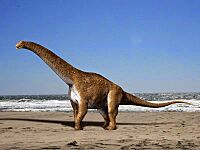 |
|
| Hypselospinus | 2010 | Wadhurst Clay (Early Cretaceous, Valanginian) | It had long spines sticking up from its backbones. |  |
|
| Hypsilophodon | 1869 | Wessex Formation (Early Cretaceous, Hauterivian to Barremian) | It might have been a low-browsing animal, like a deer, eating young shoots and roots. |  |
|
| Iberospinus | 2022 | Papo Seco Formation (Early Cretaceous, Barremian) | This dinosaur was basic but already showed signs of living partly in water. | 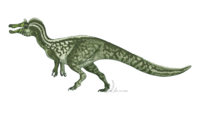 |
|
| Iguanodon | 1825 | Arcillas de Morella Formation, Camarillas Formation, Sainte-Barbe Clays Formation, Wadhurst Clay, Weald Clay, Wealden Formation, Wessex Formation (Early Cretaceous, Barremian to Aptian) | Many fossils of this dinosaur have been found, making it one of the best-known dinosaurs. | 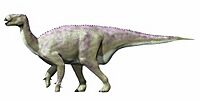 |
|
| Iliosuchus | 1932 | Stonesfield Slate (Middle Jurassic, Bathonian) | We only know it from three hip bones. |  |
|
| Iuticosaurus | 1993 | Upper Greensand Formation, Wessex Formation (Early Cretaceous, Hauterivian to Barremian) | Two types have been named, each from a single tail bone. | 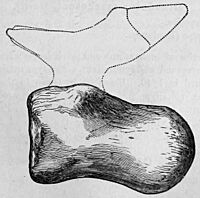 |
|
| Juratyrant | 2013 | Kimmeridge Clay (Late Jurassic, Tithonian) | It was first named as a type of Stokesosaurus. | 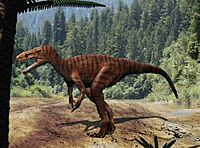 |
|
| Juravenator | 2006 | Painten Formation (Late Jurassic, Kimmeridgian) | Impressions of both scales and feathers have been found. Its tail might have had special organs to hunt fish at night. |  |
|
| Lexovisaurus | 1957 | Oxford Clay (Middle Jurassic, Callovian) | Its hip area was very large. | 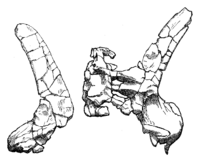 |
|
| Liliensternus | 1984 | Trossingen Formation (Late Triassic, Norian to Rhaetian) | Even though it's often shown with a head crest, there's no proof it had one. | 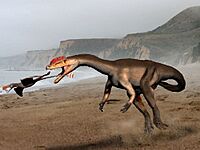 |
|
| Lirainosaurus | 1999 | Marnes Rouges Inférieures Formation?, Sierra Perenchiza Formation, Sobrepena Formation (Late Cretaceous, Campanian to Maastrichtian) | For a titanosaur, it was small and had a slender build. | 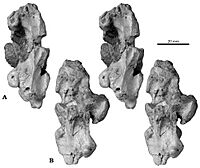 |
|
| Lohuecotitan | 2016 | Villalba de la Sierra Formation (Late Cretaceous, Campanian to Maastrichtian) | It might have had "bulb-and-root" shaped armor plates, which are common where it was found. |  |
|
| Lophostropheus | 2007 | Moon-Airel Formation (Late Triassic to Early Jurassic, Rhaetian to Hettangian) | This is the only well-known meat-eating dinosaur from the Triassic-Jurassic boundary. | ||
| Loricatosaurus | 2008 | Marnes a Belemnopsis latesulcatus Formation, Oxford Clay (Middle Jurassic, Callovian) | It had narrow, flat plates on its back and round, pointed spines along its tail. |  |
|
| Losillasaurus | 2001 | Villar del Arzobispo Formation (Late Jurassic to Early Cretaceous, Kimmeridgian to Berriasian?) | It had four different types of teeth, one of which was heart-shaped. | 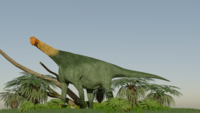 |
|
| Lourinhanosaurus | 1998 | Lourinhã Formation (Late Jurassic, Kimmeridgian to Tithonian) | More than a hundred eggs have been linked to this dinosaur. |  |
|
| Lourinhasaurus | 1998 | Lourinhã Formation (Late Jurassic, Kimmeridgian) | It was closely related to Camarasaurus but had longer front limbs. | 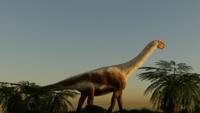 |
|
| Lusitanosaurus | 1957 | Unknown formation (Early Jurassic, Sinemurian) | It's not well known, but it was clearly large for an early armored dinosaur. |  |
|
| Lusotitan | 2003 | Lourinhã Formation (Late Jurassic, Kimmeridgian to Tithonian) | It was first named as a European type of Brachiosaurus. |  |
|
| Lusovenator | 2020 | Lourinhã Formation (Late Jurassic to Early Cretaceous, Kimmeridgian to Berriasian) | This is the oldest carcharodontosaurian (a type of large meat-eating dinosaur) known from Eurasia. |  |
|
| Macrurosaurus | 1869 | Cambridge Greensand, Chalk Group? (Early Cretaceous, Albian) | We only know it from a series of tail bones. | 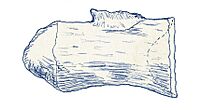 |
|
| Magnamanus | 2016 | Golmayo Formation (Early Cretaceous, Hauterivian to Barremian) | It had unusually large hands. | ||
| Magnosaurus | 1932 | Inferior Oolite (Middle Jurassic, Bajocian) | Confusingly, a fossil linked to this dinosaur was also named as a type of Sarcosaurus. |  |
|
| Magyarosaurus | 1932 | Sânpetru Formation (Late Cretaceous, Maastrichtian) | This was a dwarf titanosaur that lived on an island, making it one of the smallest of its kind. |  |
|
| Mantellisaurus | 2007 | Arcillas de Morella Formation, Lower Greensand Group, Sainte-Barbe Clays Formation, Vectis Formation, Wessex Formation (Early Cretaceous, Barremian to Aptian) | Many fossils are known. It's different from Iguanodon because it had a more slender body. |  |
|
| Marmarospondylus | 1875 | Forest Marble Formation (Middle Jurassic, Bathonian) | It's usually put in the group Bothriospondylus, but this can't be confirmed. |  |
|
| Matheronodon | 2017 | Argiles et Grès à Reptiles Formation (Late Cretaceous, Campanian) | It had very special teeth, possibly for eating tough monocot plants. | 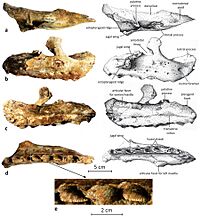 |
|
| Megalosaurus | 1824 | Chipping Norton Limestone Formation, Taynton Limestone Formation (Middle Jurassic, Bathonian) | This was the first non-bird dinosaur to be scientifically named and described. | 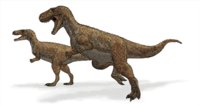 |
|
| Metriacanthosaurus | 1964 | Oxford Clay (Late Jurassic, Oxfordian) | It had relatively tall spines on its backbones for a carnosaur. | 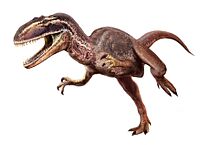 |
|
| Miragaia | 2009 | Lourinhã Formation (Late Jurassic, Kimmeridgian to Tithonian) | It had a very long neck with seventeen backbones. |  |
|
| Mochlodon | 1881 | Csehbánya Formation, Gosau Group (Late Cretaceous, Santonian to Campanian) | It was first named as a type of Iguanodon. |  |
|
| Morelladon | 2015 | Arcillas de Morella Formation (Early Cretaceous, Barremian) | It had a low sail on its back, supported by long spines. | 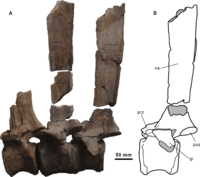 |
|
| Morinosaurus | 1874 | Unnamed formation (Late Jurassic, Kimmeridgian) | Not much is known about this dinosaur. | ||
| Neosodon | 1885 | Sables et Grès a Trigonia gibbosa (Late Jurassic, Tithonian) | No specific types are assigned to this group. It's often linked to "Iguanodon" praecursor but is actually a different dinosaur. | 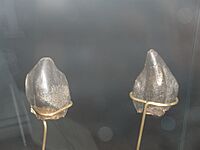 |
|
| Neovenator | 1996 | Wessex Formation (Early Cretaceous, Hauterivian to Barremian) | It had a complex system of canals in its snout. | 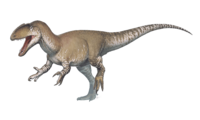 |
|
| Normanniasaurus | 2013 | Poudingue Ferrugineux (Early Cretaceous, Albian) | It represents a group of early titanosaurs that spread in Europe. | ||
| Notatesseraeraptor | 2019 | Klettgau Formation (Late Triassic, Norian) | It has features from different groups of early meat-eating dinosaurs. | 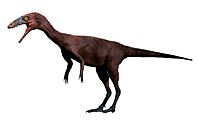 |
|
| Nuthetes | 1854 | Lulworth Formation (Early Cretaceous, Berriasian) | We only know it from jaws and teeth. It was traditionally called a dromaeosaurid, but it might be a proceratosaurid. |  |
|
| Oblitosaurus | 2023 | Villar del Arzobispo Formation (Late Jurassic, Kimmeridgian to Tithonian) | This was the largest ornithopod known from the Late Jurassic in Europe. |  |
|
| Oceanotitan | 2019 | Lourinhã Formation (Late Jurassic, Kimmeridgian) | It might be the oldest known somphospondylian (a group of sauropods). |  |
|
| Ohmdenosaurus | 1978 | Posidonia Shale (Early Jurassic, Toarcian) | It was first wrongly identified as a plesiosaur (a marine reptile). | 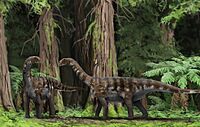 |
|
| Oplosaurus | 1852 | Wessex Formation (Early Cretaceous, Barremian) | The tooth from its first fossil was pointed, leading to it being wrongly called a meat-eating reptile. |  |
|
| Ornithodesmus | 1887 | Wessex Formation (Early Cretaceous, Barremian) | Its bones were historically mixed up with those of the pterosaur Istiodactylus. | 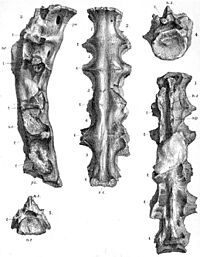 |
|
| Ornithopsis | 1870 | Wealden Formation (Early Cretaceous, Barremian) | It was first thought to be a mix between birds, pterosaurs, and dinosaurs. |  |
|
| Orthomerus | 1883 | Maastricht Formation (Late Cretaceous, Maastrichtian) | It might be a doubtful and hard-to-identify dinosaur. |  |
|
| Ostromia | 2017 | Painten Formation (Late Jurassic, Tithonian) | It was thought to be a small pterosaur until 1970, when it was re-described as Archaeopteryx. | 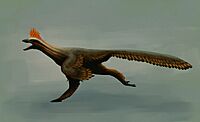 |
|
| Owenodon | 2009 | Purbeck Limestone (Early Cretaceous, Berriasian) | It was linked to Iguanodon and Camptosaurus before getting its own group. |  |
|
| Paludititan | 2010 | Sânpetru Formation (Late Cretaceous, Maastrichtian) | Some of its bones are the same as Magyarosaurus, but we can't confirm they are the same dinosaur. | 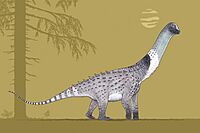 |
|
| Pararhabdodon | 1993 | Tremp Group (Late Cretaceous, Maastrichtian) | This was the first lambeosaurine (duck-billed dinosaur) found in Europe. | 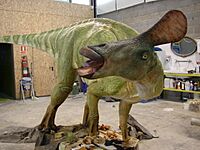 |
|
| Pareisactus | 2019 | Tremp Group (Late Cretaceous, Maastrichtian) | It's known from a single shoulder blade found in a bonebed of duck-billed dinosaurs. |  |
|
| Pelecanimimus | 1994 | La Huérguina Formation (Early Cretaceous, Barremian) | It has amazing soft tissue impressions, showing a crest on its head and a pouch like a pelican's. | 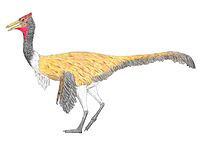 |
|
| Pelorosaurus | 1850 | Tunbridge Wells Sand Formation (Early Cretaceous, Hauterivian) | This was the first sauropod identified as a land animal. | 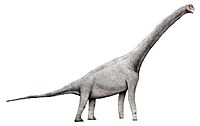 |
|
| Pendraig | 2021 | Pant-y-Ffynnon Quarry (Late Triassic, Norian to Rhaetian) | It would have lived on a dry limestone island. | 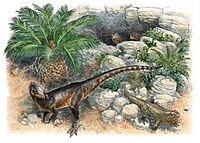 |
|
| Phyllodon | 1973 | Alcobaça Formation (Late Jurassic, Kimmeridgian) | The front and back of its teeth were not the same. | 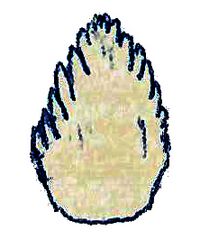 |
|
| Piveteausaurus | 1977 | Marnes de Dives Formation (Middle Jurassic, Callovian) | It has been suggested to be a type of Proceratosaurus. | 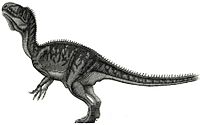 |
|
| Plateosaurus | 1837 | Klettgau Formation, Löwenstein Formation, Lunde Formation, Trossingen Formation (Late Triassic, Norian to Rhaetian) | Over a hundred skeletons are known, many of them almost complete. |  |
|
| Pneumatoraptor | 2010 | Csehbánya Formation (Late Cretaceous, Santonian) | One study suggests it might be an early palaeognath (a group of birds). |  |
|
| Poekilopleuron | 1836 | Calcaire de Caen (Middle Jurassic, Bathonian) | Its first fossil was found with fish remains. |  |
|
| Polacanthus | 1865 | Wessex Formation (Early Cretaceous, Barremian) | It had a flat shield over its hips with small bumps. |  |
|
| Portellsaurus | 2021 | Margas de Mirambell Formation (Early Cretaceous, Barremian) | It was closely related to Ouranosaurus. | 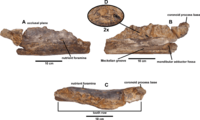 |
|
| Priodontognathus | 1875 | Lower Calcareous Grit (Late Jurassic, Oxfordian) | We only know it from a single upper jaw bone with teeth. | ||
| Proa | 2012 | Escucha Formation (Early Cretaceous, Albian) | The front of its jaw was shaped like the front of a ship. | 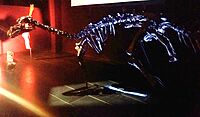 |
|
| Proceratosaurus | 1926 | Great Oolite Group (Middle Jurassic, Bathonian) | It had a small horn on its snout, which might have held a crest like Guanlong. | 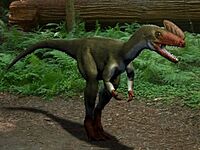 |
|
| Procompsognathus | 1913 | Löwenstein Formation (Late Triassic, Norian) | It has been suggested that it might not be a dinosaur. |  |
|
| Protathlitis | 2023 | Arcillas de Morella Formation (Early Cretaceous, Barremian) | It was large but basic for a spinosaurid. | 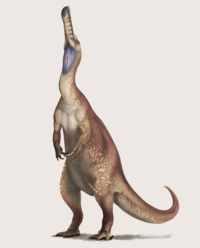 |
|
| Pterospondylus | 1913 | Trossingen Formation (Late Triassic, Norian) | We only know it from a single, large backbone. |  |
|
| Pyroraptor | 2000 | Argiles et Grès à Reptiles Formation (Late Cretaceous, Campanian to Maastrichtian) | Its first fossil was found after a forest fire. |  |
|
| Regnosaurus | 1848 | Tunbridge Wells Sand Formation (Early Cretaceous, Berriasian to Valanginian) | It might be a stegosaur similar to Huayangosaurus. | 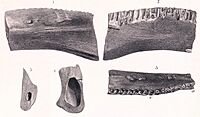 |
|
| Rhabdodon | 1869 | Gres de Labarre Formation, Gres de Saint-Chinian, Marnes Rouges Inférieures Formation, Villalba de la Sierra Formation (Late Cretaceous, Campanian to Maastrichtian) | Most rhabdodontids were dwarf dinosaurs living on islands, but this one was much larger. |  |
|
| Riabininohadros | 2020 | Unnamed formation (Late Cretaceous, Maastrichtian) | It had a thigh bone so unique that no other iguanodont had anything like it. |  |
|
| Riparovenator | 2021 | Wessex Formation (Early Cretaceous, Barremian) | It had long spines on its tail bones, a bit like Spinosaurus. |  |
|
| Ruehleia | 2001 | Trossingen Formation (Late Triassic, Norian) | It's known from a single, almost complete skeleton. |  |
|
| Saltriovenator | 2018 | Saltrio Formation (Early Jurassic, Sinemurian) | This was the biggest meat-eating dinosaur known from the Early Jurassic. |  |
|
| Sarcolestes | 1893 | Oxford Clay (Middle Jurassic, Callovian) | It was first wrongly identified as a meat-eating dinosaur. |  |
|
| Sarcosaurus | 1921 | Lias Group, Scunthorpe Mudstone (Early Jurassic, Hettangian to Sinemurian) | Its exact place in the early meat-eating dinosaur family tree has been debated. | 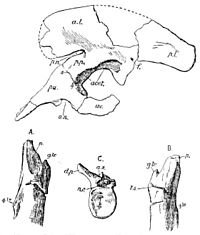 |
|
| Scelidosaurus | 1859 | Lias Group (Early Jurassic, Sinemurian to Pliensbachian) | It had hundreds of small armor plates in rows along its back. |  |
|
| Schleitheimia | 2020 | Klettgau Formation (Late Triassic, Norian) | It had a relatively large hip bone. | ||
| Scipionyx | 1998 | Pietraroja Plattenkalk (Early Cretaceous, Albian) | It was so well preserved that scientists could figure out where its internal organs were. |  |
|
| Sciurumimus | 2012 | Unnamed formation (Late Jurassic, Kimmeridgian) | It had a bushy tail, like a squirrel's. |  |
|
| Soriatitan | 2017 | Golmayo Formation (Early Cretaceous, Valanginian to Barremian) | This was the first confirmed brachiosaurid (a type of sauropod) from Early Cretaceous Europe. | 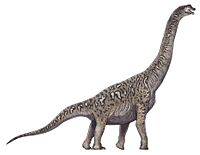 |
|
| Stenopelix | 1857 | Obernkirchen Sandstein Formation (Early Cretaceous, Berriasian) | It might be closely related to early horned dinosaurs from Late Jurassic China. |  |
|
| Streptospondylus | 1832 | Marnes de Dives/Marnes de Villers? (Middle Jurassic to Late Jurassic, Callovian to Oxfordian) | It was first thought to be a marine crocodile. | 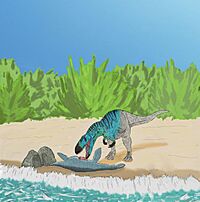 |
|
| Struthiosaurus | 1871 | Argiles et Grès à Reptiles Formation, Gosau Group, Sânpetru Formation (Late Cretaceous, Santonian to Maastrichtian) | Studying its brain suggests it had poor hearing and lived a slow, solitary life. | 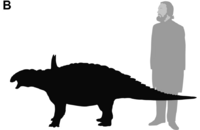 |
|
| Syngonosaurus | 1879 | Cambridge Greensand (Early Cretaceous, Albian) | It's usually seen as the same as Acanthopholis, but it has been re-identified as an iguanodont. | 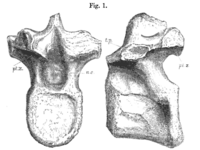 |
|
| Tamarro | 2021 | Tremp Group (Late Cretaceous, Maastrichtian) | It might have been closely related to troodontids (bird-like dinosaurs) from Asia. | 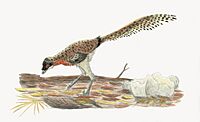 |
|
| Tanystrosuchus | 1963 | Löwenstein Formation (Late Triassic, Norian) | Its only known backbone was once wrongly identified as a phytosaur (a crocodile-like reptile). | ||
| Tarascosaurus | 1991 | Fuvelian Beds (Late Cretaceous, Campanian) | If it was an abelisaurid, it would be one of the few found in northern areas. |  |
|
| Tastavinsaurus | 2008 | Forcall Formation, Xert Formation (Early Cretaceous, Barremian) | It could represent a little-known group of macronarians called Laurasiformes. | 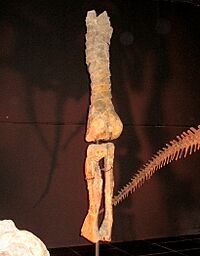 |
|
| Taveirosaurus | 1991 | Argilas de Aveiro Formation (Late Cretaceous, Maastrichtian) | We only know it from teeth. | ||
| Teinurosaurus | 1928 | Mont-Lambert Formation (Late Jurassic, Tithonian) | Not much is known about this dinosaur. |  |
|
| Telmatosaurus | 1903 | Sânpetru Formation (Late Cretaceous, Maastrichtian) | One fossil shows a facial problem caused by a tumor. | 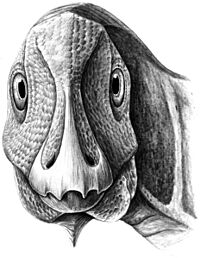 |
|
| Tethyshadros | 2009 | Liburnia Formation (Late Cretaceous, Campanian) | Its limbs were built for speed but were too short for running. | 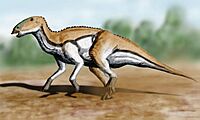 |
|
| Thecocoelurus | 1923 | Wessex Formation (Early Cretaceous, Barremian) | It has been placed in many different meat-eating dinosaur groups over time. |  |
|
| Thecodontosaurus | 1836 | Magnesian Conglomerate (Late Triassic, Rhaetian) | Fossils of this dinosaur are often found in much older rock cracks. | 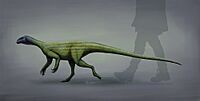 |
|
| Thecospondylus | 1882 | Hastings Beds (Early Cretaceous, Valanginian to Hauterivian) | It's hard to tell what kind of dinosaur it was. | 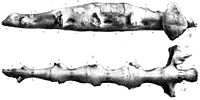 |
|
| Torvosaurus | 1979 | Kimmeridge Clay?, Lourinhã Formation, Ornatenton Formation (Middle Jurassic to Late Jurassic, Callovian to Tithonian) | The main type was found in the United States. Several types lived worldwide, including Europe. T. gurneyi is Europe's largest land predator. |  |
|
| Transylvanosaurus | 2022 | Pui Beds (Late Cretaceous, Maastrichtian) | It had a very wide skull compared to other rhabdodontids. | ||
| Trimucrodon | 1973 | Lourinhã Formation (Late Jurassic, Kimmeridgian) | It has similarities with Alocodon and Taveirosaurus. | ||
| Tuebingosaurus | 2022 | Trossingen Formation (Late Triassic, Norian) | Though first linked to Plateosaurus, it has features that show it's a more advanced dinosaur. |  |
|
| Turiasaurus | 2006 | Villar del Arzobispo Formation (Late Jurassic, Kimmeridgian to Tithonian) | It was extremely large, even though it wasn't a member of the Neosauropoda group. |  |
|
| Valdosaurus | 1977 | Hastings Beds, Tunbridge Wells Sand Formation, Weald Clay, Wessex Formation (Early Cretaceous, Berriasian to Barremian) | It was large and similar to Dryosaurus. |  |
|
| Vallibonavenatrix | 2019 | Arcillas de Morella Formation (Early Cretaceous, Barremian) | This is one of the most complete spinosaurids found in Spain. | 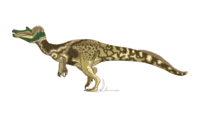 |
|
| Variraptor | 1998 | Argiles et Grès à Reptiles Formation (Late Cretaceous, Campanian to Maastrichtian) | It might be closely related to Bambiraptor. | 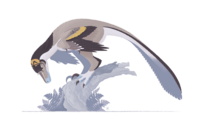 |
|
| Vectaerovenator | 2020 | Lower Greensand Group (Early Cretaceous, Aptian) | We only know it from four backbones, but they are unique enough to be a new dinosaur group. |  |
|
| Vectidromeus | 2023 | Wessex Formation (Early Cretaceous, Barremian) | It's mostly similar to Hypsilophodon but has enough differences to be a new group. |  |
|
| Vectipelta | 2023 | Wessex Formation (Early Cretaceous, Hauterivian to Barremian) | It might have been more closely related to Asian ankylosaurs than to European ones. |  |
|
| Vectiraptor | 2021 | Wessex Formation (Early Cretaceous, Barremian) | It shares some features with dromaeosaurids from North America. |  |
|
| Velocipes | 1932 | Lissauer Breccia (Late Triassic, Norian) | It has been thought to be a doubtful, unidentifiable vertebrate. |  |
|
| Volgatitan | 2018 | Unnamed formation (Early Cretaceous, Hauterivian) | It was closely related to titanosaurs from South America. |  |
|
| Vouivria | 2017 | Calcaires de Clerval (Late Jurassic, Oxfordian) | This is the oldest known titanosauriform (a group of sauropods). |  |
|
| Wiehenvenator | 2016 | Ornatenton Formation (Middle Jurassic, Callovian) | Before it was formally named, people called it "the Monster of Minden." |  |
|
| Xenoposeidon | 2007 | Hastings Beds (Early Cretaceous, Berriasian to Valanginian) | We only know it from a single, very unique backbone. |  |
|
| Yaverlandia | 1971 | Vectis Formation?, Wessex Formation (Early Cretaceous, Barremian) | It was first wrongly identified as a pachycephalosaur because of its thick skull roof. |  |
|
| Zalmoxes | 2003 | Densus-Ciula Formation, Sânpetru Formation, Sebes Formation (Late Cretaceous, Maastrichtian) | Two types of this dinosaur, with different sizes, have been named. |  |
|
| Zby | 2014 | Lourinhã Formation (Late Jurassic, Kimmeridgian) | It was first thought to be a type of Turiasaurus. |  |
Invalid and Potentially Valid Genera
- Agrosaurus macgillivrayi: This dinosaur was first thought to be from Australia by mistake. Now, it's believed to be from England and might be the same as Thecodontosaurus.
- Archaeopteryx: This famous animal had bird-like feathers but also teeth, claws, and a long tail like reptiles. It's usually seen as an early bird, but it might also be a non-bird dinosaur related to dromaeosaurids.
- Balaur bondoc: This strange dinosaur had many unique features, like strong muscles, two sickle claws, and a deep belly. It might have been a plant-eater or omnivore living on an island. Studies suggest it was either a dromaeosaurid or an early bird.
- "Bihariosaurus bauxiticus": Even though it's sometimes shown as a real dinosaur, this name was never officially published.
- Ceratosaurus: Some fossils, mostly teeth, from Portugal and Switzerland have been linked to this dinosaur, but not to a specific type.
- Darwinsaurus evolutionis: This might be the same dinosaur as either Hypselospinus or Mantellisaurus.
- Delapparentia turolensis: This dinosaur is said to be exactly like Iguanodon.
- Dinheirosaurus lourinhanensis: This might be a second type of Supersaurus.
- Gresslyosaurus: It's often thought to be the same as Plateosaurus, but there are some differences between them.
- Huxleysaurus hollingtoniensis: This might be the same as Hypselospinus.
- "Ischyrosaurus": The name Ischyrosaurus was already used for another animal. This dinosaur might be the same as Ornithopsis.
- Koutalisaurus kohlerorum: It's usually seen as the same as Pararhabdodon, but it could also be its own dinosaur group.
- Kukufeldia tilgatensis: This might be the same as Barilium.
- "Liassaurus huenei": This could potentially be a second fossil of Sarcosaurus.
- Mantellodon carpenteri: Known from a single fossil from Maidstone, nicknamed a "Mantell-piece." It was first thought to be Iguanodon, but it might be the same as Mantellisaurus.
- "Merosaurus newmani": This was first linked to Scelidosaurus, but it seems to be a meat-eating dinosaur. This name is still informal.
- "Newtonsaurus" cambrensis: It's said to be an early meat-eating dinosaur, but it might be too hard to identify within the larger group of archosaurs.
- Oligosaurus adelus: This might be the same as another group of rhabdodontids.
- Ornithomerus gracilis: This might be the same as another group of rhabdodontids.
- Pachysauriscus ajax: It's usually seen as the same as Plateosaurus, but a 2023 study said it was different.
- Pantydraco caducus: It was first named as a type of Thecodontosaurus, and it might indeed belong to that group.
- Polacanthoides ponderosus: This might be the same as Hylaeosaurus, Polacanthus, or a mix of both.
- Proplanicoxa galtoni: This might be a younger name for Mantellisaurus.
- Rhadinosaurus alcimus: It's suggested to be the same as Struthiosaurus, but it might have been a crocodile instead.
- Sellacoxa pauli: This might be the same as Barilium.
- Stegosaurus: Some bones from Portugal have been linked to this dinosaur, but not to a specific type.
- Suchosaurus: Two types have been named, both from teeth. They look just like teeth from baryonychines and might actually belong to Baryonyx.
- Therosaurus: This group was named for the original type of Iguanodon, I. anglicus. However, it was named before the main type was changed to I. bernissartensis, so it's still a younger name for Iguanodon.
- Valdoraptor oweni: This might be a younger name for Thecocoelurus.
- Wellnhoferia grandis: This might be another fossil of Archaeopteryx.
Timeline
This is a timeline of some dinosaurs from the list above. Time is shown in millions of years ago (Ma) along the bottom.

See also
- Category: Cretaceous paleontological sites of Europe
- List of European birds
- List of dinosaur finds in the United Kingdom
Images for kids



















